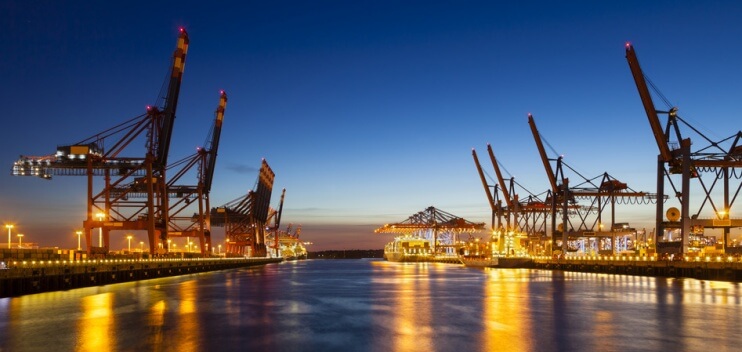What makes a Logistics Hub?
To have a city known as a ‘logistics hub’ is a goal that many politicians strive for. They believe it will bring wealth to the city and its region; but through the centuries, logistics hubs (even without that name) have risen and disappeared, so how do you know where future hubs will be?
In late 2015, the commercial leasing agents CBRE issued a report, ‘Global and Emerging Logistics Hubs’, which identified 30 current logistics hubs that play a key role in regional and global supply chains. The report also selected 20 emerging hubs that may become global logistics hubs over the next decade. Similarly, Colliers International, another commercial leasing agent issued a report in 2015 ‘From First Mile to Last Mile’, which also discussed features of logistics hubs.
Decisions about effective supply chains for your business will, in part, depend on the nodes and links selected for the supply network. As hubs are where Logistics Service Providers (LSPs) will gather, it is in their interest to promote certain locations in each region, but what makes a global logistics hub?
According to CBRE, global logistics hubs share common characteristics:
- Multiple transport options – major seaports and airports, inter-modal facilities and road highway interchanges. Regular connections to international locations via other global logistics hubs
- Abundance of facilities to process, store and distribute products
- Quick access to a large consumer market, the size of which depends on the discretionary buying power of the citizens
- Domestic economy that is heavily engaged in international trade of goods and services
- Low risk political environment
These characteristics have been considered as relevant for some years. In 1990 and 1995, Kenichi Ohmae wrote in his books ‘The Borderless World’ and ‘The End of the Nation State’, that globalisation of business provided more impetus for the development of supply chains and logistics management.
He argued that rather than selling consumer products within individual countries, companies would sell within natural regions of the world. His criteria for a region would be that it was attractive for brand development and where political disagreements were minimised; mainly within areas of larger countries or where markets between countries were more open e.g. within Free Trade Agreement (FTA) areas.
Ohmae considered that to be successful requires a region surrounding a hub to:
- Have sufficient consumer market size that citizens can share interests as consumers
- Justify ‘economies of service’ – the infrastructure of communications, transport and professional services
- Sales and after sales service networks
- Information technology and communications infrastructure
- Have a logistics services capability within the natural region of the hub that consists of at least:
- One international airport
- One sea port with international freight handling capability
- Rail inter-modal facilities
This list and the current list by CBRE are broadly compatible, so it can be assumed to be relevant for use as an evaluation tool.
CBRE also identified additional influences for the growth of a global logistics hub:
- Infrastructure investment: Consolidation of global transport, freight forwarders and distribution companies means that larger companies can exert pressure on national and state governments and port operators to improve the infrastructure i.e. ‘Post-Panamax’ size container ships require a minimum of 15m (50 ft) water depth. The potential threat is that logistics services businesses may move to another location
- Movements in supply chains: As manufacturing capacity moves to countries and areas of available and/or cheaper labour, logistics services capability will move with it. The new area may eventually develop its own global logistics hub
- Consumer service: New locations will emerge based on their transport and communications links to conurbations of consumers, enabling efficient same-day or next-day fulfilment of electronically placed orders
What may delay development of a hub?
But, while considering the positive aspects, logistics professionals must consider current and future negative aspects. For example, when assessing the rate of development for potential logistics hubs consider:
- Over the past four years, international trade has increased more slowly than the increase in global GDP. At the peak of globalisation, cross-border trade grew at twice the rate of world output. The export component of Chinese output is reducing
- Free Trade Agreements (FTAs) are not ‘free’, they only facilitate trade in agreed products and they exclude poorer countries. This could make international trade potentially more unbalanced in the future
- Currency weakness in emerging countries is affecting global trade by reducing their imports without the benefit of increased exports
- Multinational companies have reduced their international investments as geopolitical tensions increase. Private banks have increased their risk rating for lending to cross-border investments. Some companies have changed their business model from an emphasis on off-shoring to rebuilding their domestic capability (on-shoring)
- Public concern in developed countries has increased about the effect of trade liberalisation on domestic jobs and wage levels. Governments continue to be active in providing non-tariff assistance to their domestic companies e.g. credit guarantees, tax rebates for exports, export promotion funds.
Based on this limited list, will logistics hubs develop at the speed which the international leasing agents are forecasting – or hope for? Being exposed to the international trade system means there are added risks for Logistics professionals and one of them is selecting links in the supply chains based on insufficient knowledge. Be aware of the uncertainties and therefore risks and have flexibility in the organisation’s supply chains for responding to international events.

